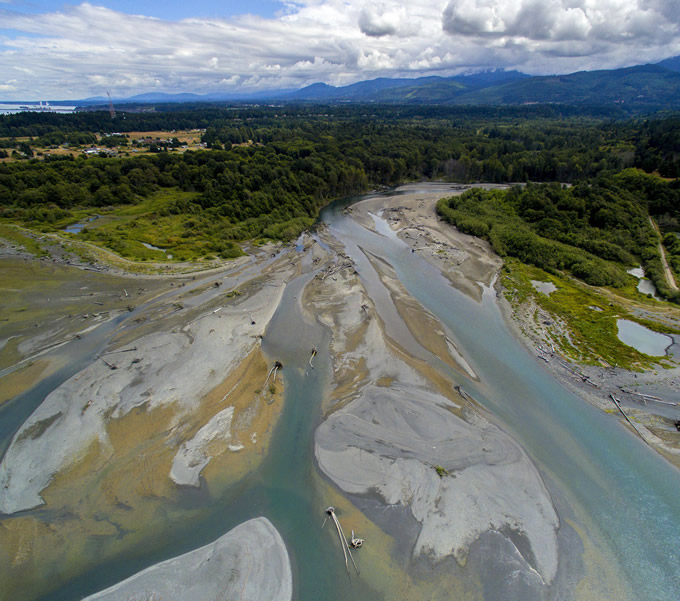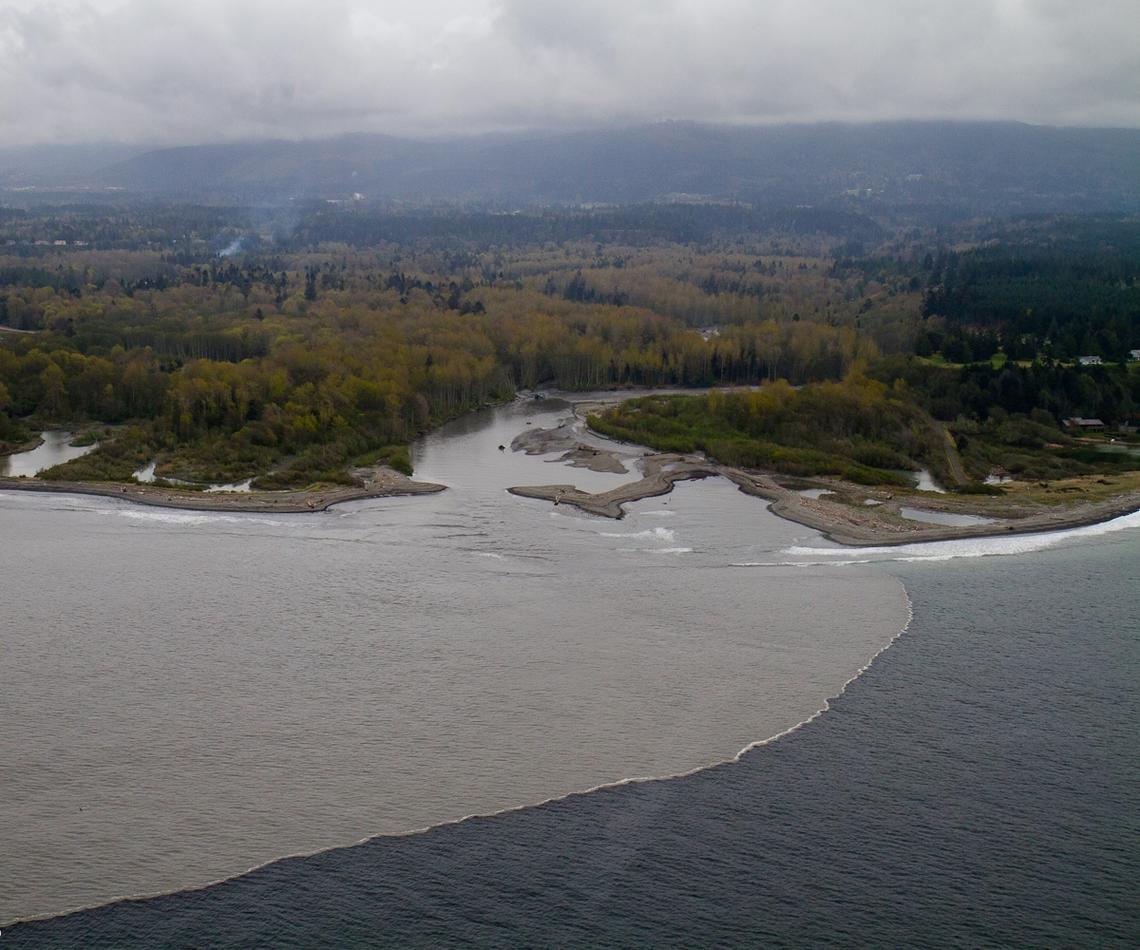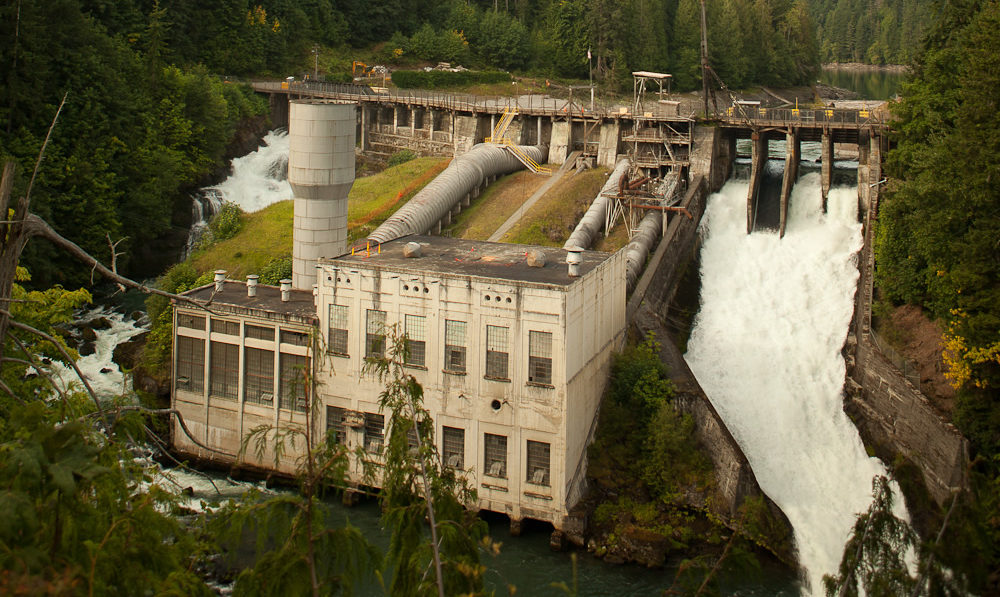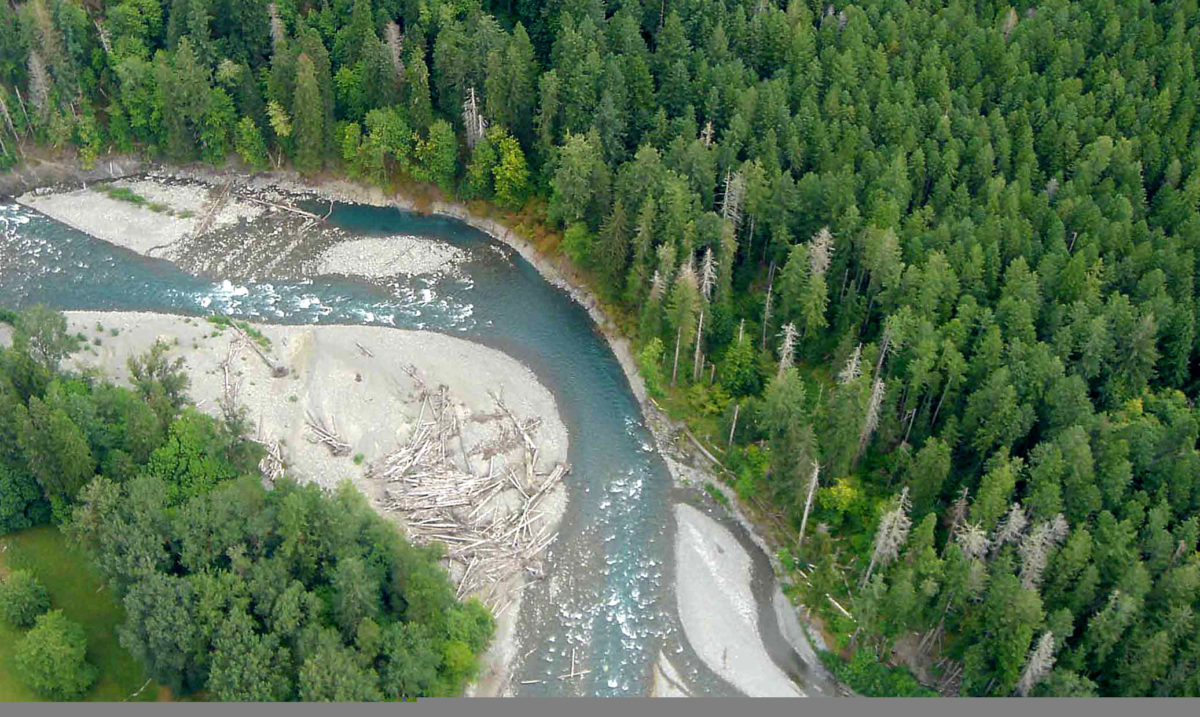Overview
In the late 1800s, the Northwest region was used to supply the lumber needed to build new cities throughout the growing United States, bringing rapid change to the Olympic Peninsula. The Elwha River was severely altered as a result. In the early 1900s, two dams, Elwha and Glines Canyon, were built. The dams fueled regional growth, but blocked salmon migration upstream, disrupted the flow of sediment and wood downstream, and flooded the historic homelands and cultural sites of the Lower Elwha Klallam Tribe. For over a century, the web of ecological and cultural connections in the Elwha Valley were broken.
In 1992, Congress passed the Elwha River Ecosystem and Fisheries Restoration Act, authorizing dam removal to restore the altered ecosystem. After two decades of planning, the largest dam removal in U.S. history began on September 17, 2011. Six months later Elwha Dam was gone, followed by Glines Canyon Dam in 2014. Today, the Elwha River again flows freely from the Olympic Mountains to the Strait of Juan de Fuca. Although the two dams removals were originally branded as salmon-restoration projects, they have had significant watershed-wide and scientific impacts.
Quick Facts
Project Location:
240148 US-101, Port Angeles, WA 98363, USA, 48.06505617676191, -123.57255231907459
Geographic Region:
North America
Country or Territory:
United States of America
Biome:
Freshwater
Ecosystem:
Freshwater Rivers & Streams
Project Lead:
National Park Service
Organization Type:
Governmental Body
Project Partners:
National Park Service
Department of the Interior
Lower Elwha Klallam Tribe
National Oceanic and Atmospheric Administration
U.S. Fish and Wildlife Service
Bureau of Reclamation
Washington Department of Fish and Wildlife
Western Washington University
University of Washington
Peninsula College
Washington SeaGrant
Elwha Research Consortium
Elwha Nearshore Consortium
Location
Project Stage:
Monitoring & Evaluation
Start Date:
1992
End Date:
2014
Primary Causes of Degradation
Dams & HydrologyDegradation Description
In the early 1900s, entrepreneur Thomas Aldwell saw the river and its narrow gorges as an economic opportunity. He sought to harness this raw, massive energy, and so he formed plans to build a hydroelectric dam. With financial backing from Chicago investors, the Olympic Power Company was formed, and the plans for the dam were materialized when construction began, in 1910. Functional in 1913, the Elwha Dam supplied energy to power the pulp mill in Port Angeles. A growing economy and a greater demand for industry led to the decision to build another dam. By 1927 Glines Canyon Dam was built eight miles upstream. Power generated by the dams helped fuel the local economy, but the failure to build fish ladders left the Elwha River with a mere five miles of available habitat for returning anadromous fish. The number of fish returning each year plummeted from 400,000 in the early 1900s to just 3,000 after the dams’ construction blocked much of the river and its tributaries.
The dams had a number of other serious impacts including sediment and silt blockage behind the dams, erosion of the river banks, and the effects on a huge portion of the park and people that previously relied on the anadromous populations for sustenance.
Defining the Reference Ecosystem
The reference ecosystem is primarily based on historical information about ecological attributes at the site prior to degradation.Reference Ecosystem Description
For millennia, the Elwha River ran wild, connecting mountains and seas in a thriving ecosystem. The Elwha River basin covers over 300 square miles (833 square kilometers), transporting freshwater and sediment from the Olympic Mountains to the Strait of Juan de Fuca. Some of the richest runs of salmon outside of Alaska, with crowded upstream to their spawning grounds in the wild Elwha River. The river ran freely through towering forests that sheltered a living community including black bears, cougars, eagles and the Klallam people. Ten different runs of anadromous fish, eleven varieties of salmon and trout, including coho, pink, chum, sockeye and Chinook salmon, along with cutthroat trout, native char and steelhead, made the pristine valley their home. For millennia these fish thrived in the river and provided food for the Lower Elwha Klallam tribe who lived along its banks.
Project Goals
- Restore the salmon and trout populations to the river.
- Restore the river habitat connectivity from the headwaters down to the coast.
- Minimize presence of invasive, exotic species.
- Restore natural ecosystem processes.
- Establish native forests.
- Comprehensively monitor the changes to the river post-removal including:
- How the rebuilding of salmon populations would unfold
- The response of resident fish populations and other aquatic life to returning salmon populations
- How and when the sediment would redistribute through the system
- How quickly the ecosystem would stabilize after full dam removal (especially the former reservoir areas)
- How released sediment would affect freshwater and marine ecosystems and their biota
- How other animals, such as ducks, river invertebrates, frogs, and black bears, would respond to dam removal and the return of salmon to the upper parts of the watershed
- How plants would recolonize and whether invasive species would influence re-vegetation in exposed reservoir areas.
Monitoring
Monitoring Details:
The Elwha River Restoration project provides a rare opportunity for scientists to learn what happens when a dam is removed and salmon return to a wild, protected river. Monitoring is being conducted as part of ongoing research efforts. Scientific monitoring and analysis for the project is led by the U.S. Geological Survey (USGS), in coordination with the Olympic National Park, Lower Elwha Klallam Tribe, the Bureau of Reclamation, Washington Department of Fish and Wildlife, U.S. Fish and Wildlife Service, the Environmental Protection Agency, the National Oceanic and Atmospheric Administration, and other local and state entities. Efforts to track the effects of dam removal on the river include monitoring and analyses of river water and sediment discharge, channel morphology, floodplain vegetation, and river geochemistry and nutrients. Researchers continue to monitor the river and nearby wildlife and have already compiled a crucial library of information about the world’s largest dam removal and restoration project to date. What they’ve learned, and how they are measuring success, will be a guiding light for future dam-removal projects.
Stakeholders
The dams’ removal was decades in the making and the result of advocacy led by the Lower Elwha Klallam Tribe and conservation groups. Today, although dam removal is complete, the restoration of the Elwha River and its ecosystem is an ongoing process. The National Park Service is working closely with Lower Elwha Klallam Tribe and many other partners to achieve those goals.
How this project eliminated existing threats to the ecosystem:
The dams themselves were the largest threat to the ecosystem, altering the natural hydrology and ecosystem of the river. The dams were removed to eliminate this threat.
How this project reinstated appropriate physical conditions (e.g. hydrology, substrate)",:
Prior to dam removal, most of the river's natural sediment flow was trapped in reservoirs behind the dams. As the dams came down, over 100 years of accumulated sediment, or 19 million cubic meters, was released downstream, making it the largest controlled release of sediment into a river and marine waters in history.
How this project achieved a desirable species composition:
The primary objective of the dam removals was to restore the salmon population by expanding their habitat and spawning ground area.
How this project reinstated structural diversity (e.g. strata, faunal food webs, spatial habitat diversity):
Park botanists and dedicated volunteers have begun the labor intensive task of reestablishing riparian areas by planting more than 400,000 native plants in the newly exposed sediment. Without the dams blocking sediment flow, the objective was to return sediment to enrich habitat along the river.
How this project recovered ecosystem functionality (e.g. nutrient cycling, plant-animal interactions, normal stressors):
More than 100 species of wildlife are known to eat salmon during one or more stages of the salmon’s life cycle. Additionally, nutrients delivered upriver by migrating salmon permeate wildlife food webs near salmon-bearing rivers. Restoring salmon populations and habitat by removing the dams is key to sustaining many species of wildlife in the riverine environment and restoring ecosystem functionality.
How this project reestablished external exchanges with the surrounding landscape (e.g. migration, gene flow, hydrology):
The two dams were removed to restore the natural hydrology and connectivity of the river.
Ecological Outcomes Achieved
Eliminate existing threats to the ecosystem:
Once removed, the natural hydrology of the river has been renewed and the river ecosystem has begun to be restored. The full extent of river restoration has yet to be realized since the project completion is still recent, so the effects of dam removal continue to materialize.
Reinstate appropriate physical conditions",:
The release of 100 years worth of sediment behind the dams caused elevated water turbidity, changes to the channel shape, and modifications to river habitats, including the renewal of sandy beach habitat near the nearshore environment where the river ends. It took only about two weeks for sediment released from the dams to reach the ocean. Some sites received as much as one to three feet of sand as the river moved the accumulation from the reservoirs.
Achieve a desirable species composition:
It’s still too early to tell how large the rebound will be for salmon populations and other species populations, but initial results are encouraging. A multitude of species have returned to the park. Adult fish from all the species have returned, including Chinook , coho. There are increases in sockeye salmon and bull trout. Pink and chum populations are still lower than desired, but overall, there has been a positive response for the majority of the populations throughout the watershed. Elwha River salmonids have renewed access to more than 70 river miles of pristine spawning habitat protected within the park.
Reinstate structural diversity:
The nearshore environment, where the Elwha River meets the sea is changing in leaps and bounds. With renewed sediment flow, sandy beaches are reappearing and nearshore habitat that once provided rich shellfish beds is reemerging. Dungeness crab, shrimp and forage fish liked by salmon, birds and other marine life quickly moved in to colonize the new sandy terrain.
Recover ecosystem functionality:
Elwha River salmonids have renewed access to more than 70 river miles of pristine and protected spawning habitat. Studies are ongoing to quantify how dam removals impacted salmon-wildlife interactions and river ecosystem functionality as a whole. One recent study found that access to salmon dramatically improves the lives of a riparian bird species called American dippers (Cinclus mexicanus). Even though these dipper populations hadn’t seen salmon for 100 years, they rapidly integrated the fish — and their nutrients — back into their diets.
Reestablish external exchanges with the surrounding landscape:
The river once again flows completely freely from the headwaters down to the strait, serving as reestablishing a key connectivity network for the surrounding landscape.
Factors limiting recovery of the ecosystem:
There were a few kelp beds just off the river's mouth that were immediately covered with sediment, but overall there is much more good habitat now and the impacts have been all positive overall.
Socio-Economic & Community Outcomes Achieved
Cultural dimensions such as recreational, aesthetic and/or spiritual:
The Elwha River is of great cultural and spiritual value to the Lower Elwha Klallam Tribe. It is thanks to their advocacy that the river restoration project occurred.
Has the project had any negative consequences for surrounding communities or given rise to new socio-economic or political challenges?:
Some of the renewed river area is not in the national park, and a local community is expressing interest in the new beach. New people are moving in, and they are building closer to the water's edge. That can lead to issues with toxic stormwater runoff and erosion.
Key Lessons Learned
- Rivers are highly efficient at transporting sediment. An estimated two-thirds of the sediment behind the dams has now moved downstream, with 90 percent of it reaching coastal habitats.
- Removing dams has allowed the river to recreate its natural sediment regime.
- The dam removal and resulting sediment flow led to the re-creation of the estuary, which has moved the mouth of the river about half a mile further out and provided new habitat for salmon and other species.
- These ecosystems can be very resilient to these large-scale perturbations
- It is important for researchers to think about the whole variety of creatures that could be impacted and try to do as much research as possible before dam removal.
- For this project, a lot of baseline research was conducted on bears, the mid-sized carnivore communities, small mammals and amphibians, but the riverine bird community was somewhat overlooked. Dippers were studied, but the other fish-eating birds and the birds at the mouth of the river were not.
-
Look at dam removal in its entirely, including what happens to the nearshore, and make sure that is a restoration priority. Dam removals should aim to optimize the nearshore environment by letting the sediment come to the shore.
Other Resources
https://www.nps.gov/olym/learn/nature/elwha-ecosystem-restoration.htm
https://pubs.usgs.gov/fs/2011/3097/
https://therevelator.org/elwha-dam-removal/
https://www.americanrivers.org/2016/09/five-years-later-elwha-reborn/






